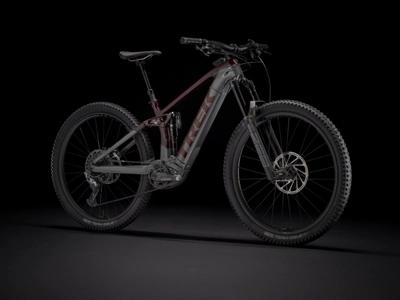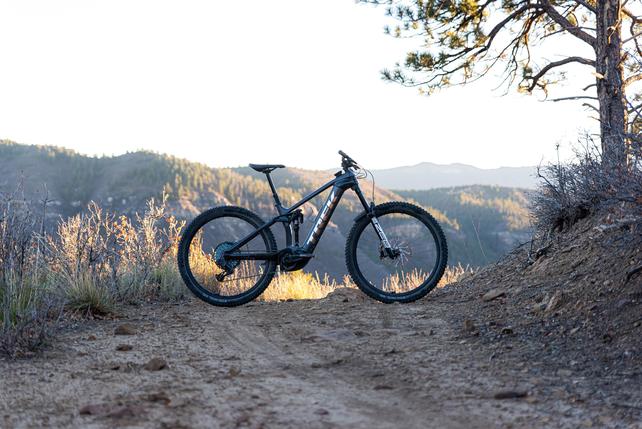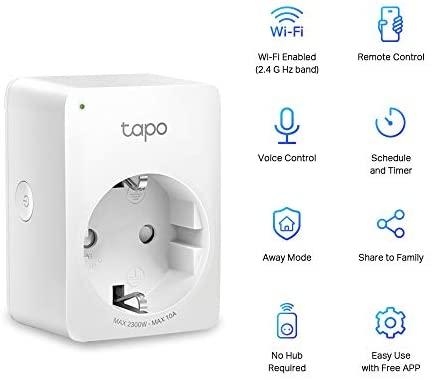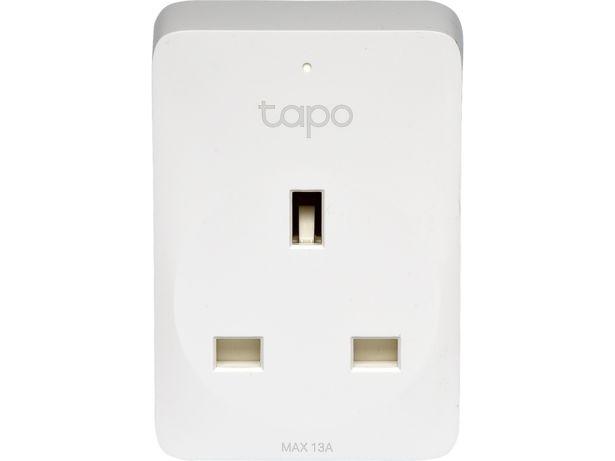Trek Rail 9.9 AXS eMTB—Greatness Bedeviled by Gremlins
The Takeaway: On singletrack, the Rail 9.9 AXS is a superb e-bike. But wonky electronic accessories and the locked-down Bosch Smart System tarnish its greatness.
Price: $13,500 (Rail 9.9 AXS as tested)Weight: 51.3 lb.(medium)
View Gallery Buy Now
Matt Phillips
2022 Trek Rail—What’s New
For 2022, the high-end Trek rail models—the 9.8 and 9.9—get a new frame with geometry inspired by the Slash, as well as Bosch’s latest e-bike system (more on both below). Besides geometry, the new frame features a larger diameter seat tube for 34.9mm dropper posts, a bit more tire clearance (now fits 2.6-inch rear tire), and a new Knock Block with an increased (72 degree) turning radius.
2022 Trek Rail—Bosch Smart System
Matt Phillips
The Rail 9.8 and 9.9 use Bosch’s new e-bike ecosystem, which the company calls “Smart System.” One important note: Bosch’s 2022 Performance Line CX motor for Smart System offers identical performance to the previous Performance Line CX. But while motor performance hasn’t changed, almost everything else has.
One of the most significant changes is the new, larger, 750Wh battery (for most sizes—more on this below), a significant bump up from Bosch’s previous 625Wh battery. That gives the Smart System Trek Rail one of the biggest batteries: larger than a Specialized Levo’s 700Wh battery and the new Pivot Shuttle’s 726Wh battery. (Norco still wins the battery game with its optional 900Wh battery for the latest VLT models.) There’s also a new 4A charger that’s only compatible with the new battery—Bosch’s older charger does not work with the new battery, even though the plug looks the same.
The range is very condition-specific, but I did a 31-mile ride with over 2400 feet of climbing using a combination of eMTB (mostly) and Turbo (occasionally) modes and finished with plenty of battery remaining (I forgot to write it down, but I remember being impressed: Around 40 percent remaining sticks in my brain).
Unfortunately, the 750Wh battery does not fit in the size small Rail frame, so those must make do with a 625Wh battery.
Matt PhillipsOther new Smart System bits include a new Kiox 300 color display and a new handlebar remote. The latter is large and seems overdone (six buttons, lots of lights), and it looks like it just wants to get wrecked in a crash. The lower profile remotes of Specialized and Shimano seem more suitable for mountain bike riding.
On the Rail, the Kiox display resides on the top tube just behind the stem. This enduro placement keeps it more protected in a crash but also harder to look at while riding. It is a bright and clear display, though it’s not customizable and has some other faults I’ll get into later.
A new smartphone app named Flow ties the whole system together. It connects to the Smart System bike and records activates—a GPS track, elevation, speed, distance, power, and cadence—which riders can then download as a GPX file and manually upload to their favorite ride logging site. At present, you can’t pair a heart rate monitor to the Kiox (or the Flow app), the only service integration built into the Flow app is Apple Health, and there’s no web portal for accessing the information.
Matt PhillipsTrek and Bosch representatives hinted that heart rate connectivity to the Kiox, Strava integration, and a web portal are coming in future updates. The app also allows riders to push over the air updates to the bike, tune some assist modes, and provide information about the remaining range and other ride metrics. Activity tracking is not perfect, however. On one occasion, I started the ride with the Flow app paired with the bike, but I saw it did not record elevation or the GPS track when I finished the ride.
One annoying thing about the Smart System: it only talks to Bosch computers. You can’t connect a Garmin or Wahoo computer to a Bosch e-bike (Shimano and Specialized e-bike systems connect to third-party GPS computers). So, if you’re like me and ride with heart rate and use Strava, you have to use the Kiox—the bike doesn’t function without the Bosch display—and a Garmin or Wahoo.
Matt PhillipsBosch has a locked ecosystem where bikes with their systems only work with their displays and their apps. This, in my opinion, is dumb and highly frustrating from a user’s perspective. Specialized and Shimano’s systems work with third-party products and services, why can’t Bosch’s? It also makes me fear that there’s some sort of subscription lurking on Bosch’s roadmap, which forces you to pay to access features or updates. As you’ll see below, the Bosch motor is excellent, and the Rail is a very good bike, but the locked ecosystem, the lack of features compared to the competition, buggy activity tracking, and the hulking handlebar remote are very annoying.
2022 Trek Rail 9.9—All The Wizards
The top-of-the-line Rail 9.9 models get Quarq TyreWiz and RockShox AirWiz sensors. These pressure sensors (in a perfect world) provide a quick visual check to let you know if the tire and suspension pressure is in the proper range. For example, slow blinking red means the pressure is too low; fast blinking red means it is too high; blinking green means it’s in the correct range.
Matt Phillips
Note that the AirWiz is not the same as SRAM’s ShockWiz: The latter is far more advanced and collects much more information. AirWiz simply tells you if your pressure is in the proper range.
You still set up your suspension the old-fashioned way: put enough air in the fork and shock to achieve your sag. Then, after you know your suspension pressures, you use SRAM’s AXS app to set the AirWizards target pressures: When they drift plus or minus five PSI from the target pressure you selected, you’ll see a red light. The app suggests suspension pressures, but I found them way off for both the fork and the shock.
It’s much the same for the TyreWiz, though you can select a plus/minus PSI range of one to 20 (?) PSI. I don’t like that you can only set PSI in whole numbers, and I prefer my tires at 23.5 in the front and 26.5 in the rear (those pressures result from a lot of time and experimentation). I also wish you could set a smaller plus/minus range: 22.5 PSI and 24.5 PSI are, to me, a lot different than 23.5.
Matt PhillipsAssuming they work as they should—one of my TyreWizards read minus 23.5psi with no pressure in the tire and zero with the tire at 23.5psi—it is, in theory, nice to have a quick way to check and see if your pressures are correct. But the wizards don’t seem to wake up consistently, and app pairing is wonky. For example, to see pressure changes in the shock, I’d need to open the app, connect the AirWizard, read the pressure, adjust the pressure in the shock, close the app, open the app, reconnect the AirWizard, read the pressure… repeat until I hit the proper pressure.
Then there’s the drawbacks: all of those batteries, the increased size of the shock (which eats into clearance), and the fact that you’re supposed to remove the TyreWyz and install a little plastic spacer if you’re going to inject tubeless sealant through the valve.
We’re talking about $12,500 to $13,500 bicycles here: any added gizmo should be flawless and seamless. The Wizards are far from that. Frankly, I think Trek should save the rider a lot of money and hassle and just ship the bike with a digital air pressure gauge and a digital shock pump.
2022 Trek Rail Models
courtesyThere are five Rail models with the Bosch Smart System. They are:
There are also three lower-priced Rail models—two aluminum, one carbon—with Bosch motors, but without the Smart System. These models also use the previous generation Rail’s frame and not the new frame with the new geometry and other updates of the more expensive models.
Trek Rail—Geometry
The Rail 9.8 and 9.9 models get revised geometry inspired by the Slash. Compared to the previous Rail, teach grows by an average of 19mm per size, and the seat angle gets two degrees steeper.
courtesyTrek’s Mino Link in the rocker link offers a low and high geometry position with a +/- 0.4-degree change in angles (64.6° or 64.2° HTA and 77.1° or 76.7° STA) and six millimeters of BB height change. Trek ships the bike in the low position and recommends high for mullet (27.5-inch rear wheel) setups. There are four frame sizes (small through extra-large), though the small size frames are currently unavailable.
courtesyThe Rail 5, Rail 7, and Rail 9.7 carry forward with the geometry of the previous generation bike.
Trek Rail 9.9 XX1-AXS Ride Impressions
I loved riding the Trek Rail 9.9. It handles well, the suspension is excellent (once again, the extra weight of an e-bike makes the suspension, especially the fork, feel extra smooth and supple), and Bosch’s motor is excellent—especially the e-MTB mode.
But, all the gremlins from the Wizards, apps, Kiox computer, and the locked-down ecosystem that doesn’t work with a hugely popular ride logging platform (Strava) or connect to hugely popular GPS computers (Garmin or Wahoo) computer are just ridiculous.
A few more examples of the annoyances I encountered. There are four riding modes, but Bosch only lets the user customize two of them: Shimano and Specialized let the user customize all the riding modes. The battery—even when on the charger for 24 hours—wouldn’t charge more than 97-percent. And the data screens on the Kiox cannot be customized: a feature found on even low-cost cycling computers.
Electronics, apps, and connectivity are an increasing part of the cycling experience, especially the e-bike experience, and especially the high-end e-bike experience. But while the goal of all these features is a better user experience, it’s the opposite when those features are buggy or don’t work at all. On an unpowered bike you can replace the brakes if you don’t like them, or take the Fox fork off and install a RockShox if it is a better fork. But on an e-bike, you can’t change out the drive system and its display, or use Shimano’s e-bike app to tune your Bosch e-bike motor.With the Rail, you’re wedded to the Bosch Smart System and the rest of its ecosystem for the life of the bike.
Ideally, a bike should be flawless and easy to live with; yet, some of Rail’s the flashiest features were quite the opposite. So many times, I felt like I ran into a brick wall while trying to get it to do something that is easy to do with another e-bike—if it could at all—or get some gizmo to work as advertised. Apps, software, and firmware, however, are never done. Bosch and SRAM could roll out updates and a lot of the frustrations I encountered on the Rail could go away in a blink. I hope that blink comes soon.
Matt PhillipsBut, when I got out on the trail with the Rail, and I almost—almost—forgot about the gremlins and annoyances because it is brilliant on the trail. And despite all my complaints about the Bosch system, one of the best parts about the Rail is the motor.
Matt PhillipsRail 9.9 XX1 AXSTrektrekbikes.com$13,499.99Buy NowThe maximum quoted torque is 85Nm, the same as a Shimano EP8, but the Bosch motor feels stronger. It feels close to and maybe even a bit more potent than Specialized’s 95Nm “Full Power” motor. It doles out power beautifully, especially in eMTB mode, which let me flow through low-speed technical sections with challenging traction without lurching yet offered a full-power boot when I stomped on the pedals, accelerating out of a switchback. I’d put the Bosch equal with the Specialized motor at the top of my list as far as the motor tune goes. I still give the overall edge to the Specialized though, because the Bosch has a high-pitched whine, some inelegant clunking, and a bit of vibration that the ultra-smooth and quiet Specialized motor does not have.
That great motor is attached to a well-done chassis. Of the three longer-travel e-bikes I’ve been r this year (the Levo, the Yeti SB160, and the Rail), the Rail feels the most tossable to me. It’s a robust bike free of detrimental flex but still feels supple and lively—surprisingly so for an e-bike.
Matt PhillipsThere’s excellent suspension here too. Or was once I figured out that the weird harshness and noise I felt/heard on larger hits came from the shock’s reservoir smashing into my water bottle. I scooched the bottle cage up enough that the shock cleared the bottle, the rear end got smoother, and the bike got a whole lot quieter. There was great support on climbs and higher G corners, with little harshness on square-edge bumps and impressive sensitivity on smaller bumps.
I got the same performance from the e-bike tuned Zeb on the front once I dialed up the low and high-speed compression clickers (both eventually wound up in the middle of their range)—I think RockShox’s ebike fork tune is slightly more on point than Fox’s. Even so, I’d still drop a DSD Runt in this fork for a bit more mid-stroke support and finer progression tune.
Trek’s updated geometry is longer than the previous Rail, but even so, it’s not a crazy long bike. Overall, I think they’ve hit a nice balance: It’s stable at speed and composed when dropping into the steeps but remains deft and manageable at lower speeds. Even though the geometry comes from the enduro-oriented Slash, this bike rides and feels like an all-arounder to me: You won’t mistake it for a poppy play bike, nor an enduro sled.
The seat angle is reasonably steep at 76.1°, and considering the precipitous climbs you can power up on this bike, it’s probably about right. Even so, I pushed the saddle back on the rails a bit because I felt too far forward on lower angle climbs and flats.
Matt PhillipsAs this is a Trek, this Rail gets the entire suite to Bontrager house brand components. Most worked just fine, though the Line Pro dropper was sluggish, and the remote is meh at best. Again, $13,500 bike—let’s get a Bike Yoke Revive on this, not some mediocre house brand thing. The SE6/SE5 tire combo worked well in my conditions, though I did wish for a sticker compound at times. The casings held up better than I expected—no flats so far—though I think we’re at the point where all 50 pound, 150mm-plus travel e-bikes should get Cush Core liners (or similar) for extra flat protection and tire support. I’ll also reiterate the statement I made in the 160E review about SRAM’s Code brakes with 220mm (front) and 200mm (rear) rotors: they’re enough brake, but only barely. I think we’re at the end of the era where repurposing components designed for unpowered bikes is good enough for a modern e-bike.
Matt PhillipsTrek Rail 9.9 XX1—Verdict
If it wasn’t clear already, I had a love/hate relationship with the Rail 9.9 AXS. All the electronic gremlins and that locked-down Bosch system—ugh. It’s difficult to recommend the Bosch when the Specialized and Shimano e-bike systems offer excellent performance without the headaches. Hopefully, Bosch and SRAM will work out the issues with updates. And if Bosch continues with their closed system, they have to add all the features its competitors offer, and its platform lacks. Because in this guise, I can’t recommend the Rail without reservation.
But once I got it out on the trail, I loved the Rail. It is one of my favorite e-mountain bikes and the best e-all-arounder I’ve ridden so far.



